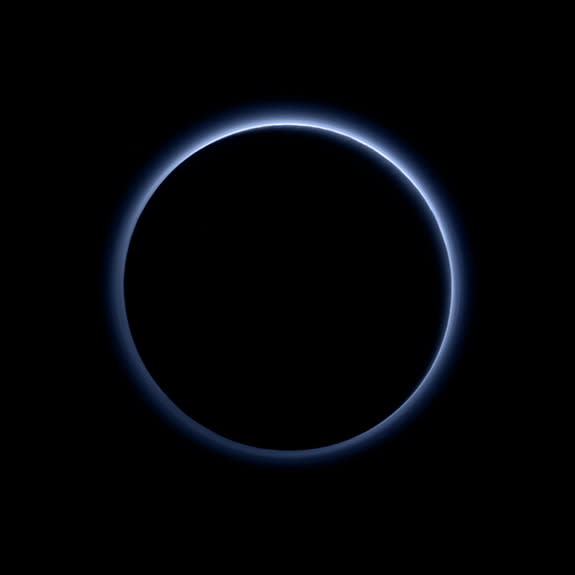Surprise! Pluto Has Blue Skies (Photo)
The more scientists learn about Pluto, the more interesting the dwarf planet gets.
During its historic flyby of Pluto this past July, NASA's New Horizons spacecraft discovered towering ice mountains and vast glaciers on the frigid body. And now, flyby images recently beamed home by New Horizons reveal that the faraway dwarf planet has blue skies similar to those of Earth.
"Who would have expected a blue sky in the Kuiper Belt?" New Horizons principal investigator Alan Stern, of the Southwest Research Institute (SwRI) in Boulder, Colorado, said in a statement today (Oct. 8). The Kuiper Belt is the ring of icy bodies that lies beyond Neptune's orbit. "It's glorious." [Destination Pluto: NASA's New Horizons Mission in Pictures]
The newly received image is the mission's first color photo of Pluto's atmosphere, team members said. (New Horizons sent home atmosphere photos shortly after the July 14 close approach, but they were all in black and white.)
The blue color comes from complex organic molecules in Pluto's atmosphere called tholins, which are themselves probably gray or red but scatter light in blue wavelengths, New Horizons team members said. The same basic phenomenon explains why Earth's sky is blue.
"That striking blue tint tells us about the size and composition of the haze particles," mission team member Carly Howett, also of SwRI, said in the same statement. "A blue sky often results from scattering of sunlight by very small particles. On Earth, those particles are very tiny nitrogen molecules."
Ultraviolet radiation from the sun breaks apart nitrogen and methane high up in Pluto's tenuous but extended atmosphere, allowing tholins and other complicated molecules to form, researchers said. The tholins eventually drift down to Pluto's surface, which explains why the dwarf planet sports a reddish-brown hue.
These tholins typically settle onto ices composed of nitrogen and other exotic substances (exotic to those with Earth-based sensibilities, at least). But some regions of exposed water-ice do exist on Pluto's surface, newly received New Horizons data reveals.
Mission scientists said they aren't sure why the water ice crops up where it does — generally, in some of the reddest areas on Pluto.
"I'm surprised that this water ice is so red," said science team member Silvia Protopapa, of the University of Maryland. "We don't yet understand the relationship between water ice and the reddish tholin colorants on Pluto's surface."
New Horizons sent back a small portion of its flyby data shortly after the epic encounter but stored most of this treasure trove on board for later transmission. The spacecraft began beaming the entire data set back to mission control last month; all of it should be on the ground by the end of 2016, team members have said.
New Horizons is currently 3.1 billion miles (5 billion kilometers) from Earth and in good health. The mission team aims to perform a flyby of a second, much smaller Kuiper Belt object in early 2019 if NASA approves and funds an extended mission for the spacecraft.
Follow Mike Wall on Twitter @michaeldwall and Google+. Follow us @Spacedotcom, Facebook or Google+. Originally published on Space.com.
Copyright 2015 SPACE.com, a Purch company. All rights reserved. This material may not be published, broadcast, rewritten or redistributed.



